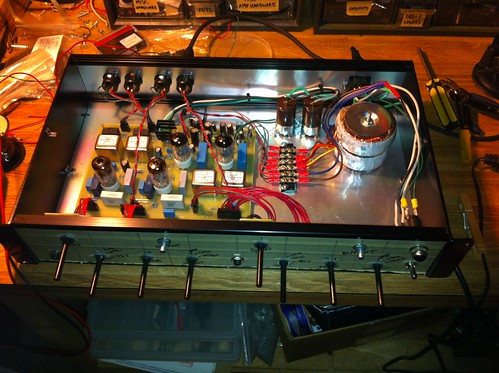MeToo2
Well-known member
phelar said:Hi again.
I got some new questions. How do i messure the preamps noice level in a proper way? When i got the g9 knobs turned down and the input gain on my mbox1 turned down i read -105db at 100hz and -110db at 200hz. This is with a dynamic mic on the input. How do i make a 200 ohm dummy load and exactly how do i connect it to the input. I want to compare readings with other g9´s.
I dont really know where to turn the gain knob on my mbox1 to get fair readings :-[.
A dummy source is one that has the same impedance as an expected source.
This could be as simple as a 200R resistor soldered between pins 2 & 3 on an XLR plug.
You plug it in instead of a dynamic mic.
A dummy load is one that has the same impedance as an expected load.
This could be as simple as a 600R resistor soldered between pins 2 & 3 on an XLR socket.
You plug it in instead of your real terminated load. [although not many studios bother to terminate their 600 ohm busses nowadays]
First you need to do is calibrate your audio interface and measuring equipment to the real World.
One way of doing this is to output a known sine wave from your DAW test signal generator at around 50Hz into a 600R dummy load. Now measure the voltage between pins 2 & 3 of the XLR cable with an AC multimeter and adjust your DAW test signal generator level until it reads 776mV volts RMS (or there abouts). This level on the DAW is 0dBm. +4dBm [4 dB higher than that level on the DAW] should measure around 1.228V. If you have a better quality multimeter [True RMS], or an oscilloscope, you can use a higher frequency for calibration.
Now you need to see what level this generates on your audio input: loop your output to your input with a physical patch cable on your audio interface. Set the DAW output level to output your +4dBm sine. Set your audio input pads off and the input gain trim on the audio interface to 0dB. What does your DAW input meter read? It may not read the same as the DAW output, as input dBFS sensitivity does not always match output dBFS!
In my particular DAW and for my particular audio interface I know that a -11dBFS test signal generator app in logic connected to a line level output channel corresponds to +4.47dBm in the real world (1.296V). But this results in -14dBFS measured in the Logic Multimeter app on a line level input channel via an external physical loopback patch. So there's a "hidden" 3dB of loss in my interface.
There are many ways of measuring noise. Perhaps the most important ones if you're concerned about your PSU performance are:
1. Basic maximum gain of your G9. Loopback your audio interface using a patch cable. Adjust the output for something around -60dB FS sine or if you've calibrated your audio interface -60dBm [in my case that's -71dBFS]. Check the input level (remember, it may not be 60dB FS due to some internal system gain or difference between input and output sensitivity). That's not so important. Now replace the loopback patch with your G9 with maximum gain. Measure the input level now, and how much more level there is on maximum gain with the same test tone compared to before.
2. EIN (equivalent input noise) = a terminated dummy source and gain turned to max. & measure the noise floor on the audio interface input relative to dBFS. Add the maximum gain of the G9 you measured in 1. Subtract the level in your DAW corresponding to your nominal level of +4dBm on the input [-14 in my case].
3. Cross talk = a terminated quiet input on one channel. Set up a known test tone on the other channel at reference level e.g. +4dBm out. Measure the amount of test tone present on the "quiet" channel. Note this is frequency dependent. Yo can also set up a pink noise generator on one channel, and then you will see how good your PSU filtering/ inter channel isolation really is at all frequencies.
Less important (as you probably want a bit of color in a tube amp)
4. Intermodulation distortion = insert two sine tone generators on one channel e.g. 1Khz and 1.5Khz and measure the amount of intermodulation products (500 Hz, 2.5Khz, 3.5Khz, 4.5KHz etc) on the output relative to the 1Khz and 1.5Khz test tones.
There's a pretty good note here: http://www.rane.com/note145.html explaining the different types.


























![Soldering Iron Kit, 120W LED Digital Advanced Solder Iron Soldering Gun kit, 110V Welding Tools, Smart Temperature Control [356℉-932℉], Extra 5pcs Tips, Auto Sleep, Temp Calibration, Orange](https://m.media-amazon.com/images/I/51sFKu9SdeL._SL500_.jpg)







